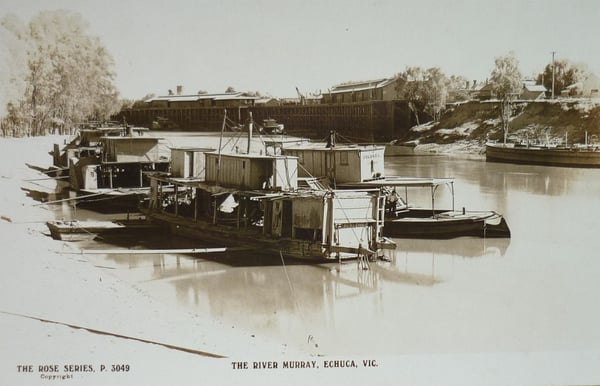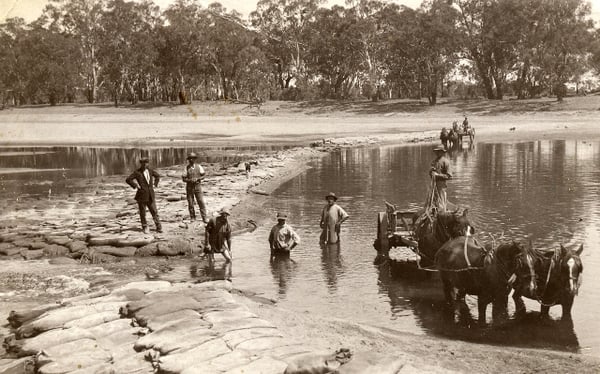The Murray River is a true icon of Australia’s natural beauty, its culture, and its tourism appeal. At around 2500 kilometres long, not only is it the longest river in Australia, but in fact it’s one of the longest rivers in the world! As part of the Murray-Darling Basin (MDB) which is more than one million square kilometres in size, the River is also a crucial source of water for more than one million homes, in addition to farming businesses and other operations which take place within its surrounds. The spectacular visual changes of The Murray present a wild picture of the ever-changing climate as it swings from drought to flood, a constant reminder of the severity that climate risk plays in Australia.
Accordingly, there can be no disputing how important the Murray has been to Australia historically and extreme climate risk. This remains the case today, and that working to maintain the Murray and the wider MDB is crucial. This so that it can continue to serve as a source of economic activity among those who depend upon it for their livelihoods, as well as a destination which delivers unforgettable experiences for all from further afield who visit to take in the Murray, and the broader MDB’s natural beauty and environment. So let’s look now at what must be done to maintain the Murray region throughout the 2020s.

The History of the Murray
In order to map a path for the future of the Murray region, it’s essential to recognise its history, and in turn the importance of the River and its surrounds to Australians in previous generations. The natural history of the River places its age at around 130 million years!
Evidence of activity around the Murray by the First Australians can be traced back to in excess of over 40,000 years ago, and between then and more recent times the River was used as a source for fishing by indigenous tribes, alongside other activities. Europeans first became aware of the Murray in 1824, with the journey by explorers Hamilton H. Hume and William H. Hovell.
In the period of history to follow the Murray has grown to become critically important to the operation of modern day Australia. Significant cities like Albury and Wodonga straddle its banks, tourism attractions like steamship paddlers make their way up and down the river each day, and the great majority of Australia’s citrus fruits, stone fruit, and pome fruit are grown within the MDB. Yet while conserving the Murray and MDB is indeed important, it’s certainly not always been easy.
Accordingly, having an understanding of its prior challenges informs a discussion about what action should be taken to reduce the impacts of climate risk in the future.
Threats to the Murray and MDB
To those who live within the Murray region and see its health (or lack thereof) shift from one season to the next, it won’t be news that the locale is one where profound changes in the environment can be seen depending on seasonal weather and environmental conditions. In turn, that life and work in this region during the 2000s has certainly been challenging through many years.
The fact is the drought between the start and end of the new millennium’s first decade - commonly attributed as between 2001 and 2009 - was the worst on record. In actual fact, the seeds of it were already sown in southern Australia before the 2000s began, with Australia’s Bureau of Meteorology contending the drought began in 1996. The development of the Basin Plan has its origins during this first decade of the 2000s, and it sought to balance environmental and economic needs surrounding the Murray and the MDB
Though the Millennium Drought had ultimately ended by 2010, more recently, the drought between 2018 and 2020 - while not as severe overall - nonetheless brought its own unique anguish. For instance, it delivered the lowest rainfall in recorded history. These examples are a mere snapshot of the problems that’ve been posed to the Murray and MDB during this century, but they illustrate a confronting but clear-cut reality.
Not only have immense hurdles been placed in the path of those who live and work in the MDB in years that are all too recent with the Millennium Drought, but in fact new issues like the lowest rainfall incident have also arisen in just the past few years. As a result, it must be understood that while these droughts are in the past, they are certainly not now to be forgotten about. Furthermore, incidents such as the challenge of erosion along Barham’s river boardwalk - an attraction built and beloved by the local community - illustrate the ongoing threats posed by weather and environmental incidents to the Murray and MDB.

Problems Throughout the 2020s
It’s known there remains ongoing critique surrounding the capacity of the Basin Plan to adequately respond to future challenges that are anticipated in the years ahead. The particulars of the debate surrounding the Basin Plan are beyond the scope of this article, but it’s essential to understand that the Plan is yet to have universal confidence.
Accordingly, when it comes to the the future of the Murray and the whole MDB, possessing a broader frame of reference is important when seeking to gain a clear-cut picture of the challenges - alongside the opportunities! - that are set to arise in this decade. Particularly for any organisation that is seeking to devise and deploy a climate risk mitigation strategy that maximises their ability to pursue ‘business as usual’ going forward, even whilst the risk of weather incidents is set to increase.
Taking Action This Year
When it comes to mitigating the impact of climate risk, the next 10 to 15 years will be critical. The Early Warning Network features a team with expertise in meteorology, climate intelligence and spatial risk, offering round-the-clock monitoring of weather and climate risks for our clients, and our staff are ready to provide the insightful data necessary for organisations to make informed decisions about operations in this 10 to 15 year time period.
To discuss how we can help your business call (02) 6674 5717, email support@ewn.com.au, or contact us via our enquiry page here.